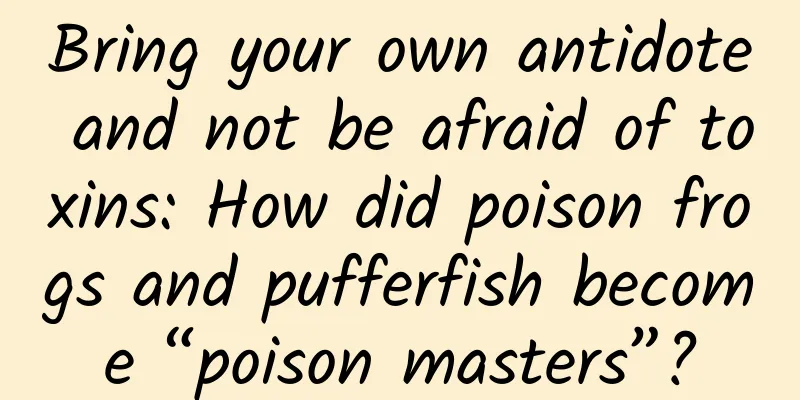Bring your own antidote and not be afraid of toxins: How did poison frogs and pufferfish become “poison masters”?

|
There are so many poisonous animals in nature. Have you ever wondered how these poisonous animals produce toxins? How do poisonous snakes, pufferfish and other "poison masters" manage to poison their enemies at will without being poisoned themselves? Isolate storage, safe and secure For items that are toxic or need to be handled with care, we usually isolate them and store them in places where we don't normally touch them, and then take them out when we need them. For example, medicines, lighters, etc. Similarly, poisonous organisms also use this strategy when storing toxins, storing the toxins they produce in a specific "room". In many people's impressions, jellyfish is a very delicate creature, but it is not known that the seemingly weak jellyfish is also a poisonous creature. Every year, many tourists touch the jellyfish washed up on the coast and develop allergic symptoms, or even fatal dangers. How do jellyfish, whose body structure can be seen at a glance, isolate and store toxins? It turns out that there is a harpoon-like structure in the tentacles of jellyfish, called stinging cells. The venom of jellyfish is stored in the stinging cells. When stimulated by external factors, the stinging threads in the stinging cells will pop out and pierce the body of the attacked object, releasing the venom. The entire process of spitting out venom does not affect the normal functioning of other organs in the jellyfish's body. This venom-emitting mechanism of the jellyfish can attack the enemy without poisoning itself. Illustration of stinging cells ejecting stinging filaments Image source: wikipedia Similar to jellyfish, the venom of venomous snakes is also stored in a "special place" - the venom gland in the upper part of the mouth. The only outlet of this special place is the fang. When the venomous snake bites the enemy, the venom will be injected into the enemy's body through the fang. The location of snake venom storage. Image source: Sima Yi of SME Bring your own antidote, no fear of toxins In addition to setting aside separate "rooms" to store toxins, some animals have even evolved a "live and die together" relationship with toxins. As one of the most toxic species in nature, the poison dart frog may look very cute, but it is very deadly. There is an alkaloid in its skin glands, which can permanently block the transmission of nerve signals to muscle cells, causing the muscles to remain tense and unable to relax. The toxin in a golden poison dart frog can easily kill 10 adults in 3 minutes. Interestingly, poison dart frogs do not produce toxins in captivity because their poison comes from poisonous spiders and other foods they eat. Why can poison dart frogs reuse the toxins instead of being killed by poisonous spiders? This involves the working principle of toxins in cells. The neurotoxin in the poison dart frog is called poison dart frog toxin. After entering the animal's body, this substance will combine with the surface receptors of nerve cells (this receptor is mainly responsible for transferring ions inside and outside the cell, thereby affecting the state of the cell), thereby interfering with the work of transmitting nerve signal substances under normal circumstances, and thus affecting the normal functioning of the nervous system. Nerve cells need specific receptors to open ion channels Under normal circumstances, receptors need a specific matching "key" to open the door to transmit ions and transmit nerve signals. The poison dart frog toxin in the poison dart frog is like a master key, disguising itself very well, making the nerve cell receptors "dazzled" and transmitting wrong signals, thus disrupting the normal operation of the nervous system, causing symptoms such as high blood pressure and dizziness, and in severe cases, even death. Cobalt blue poison dart frog Image source: Zifei.com The reason why poison dart frogs are not affected by this toxin is not because the nerve cell receptors in their bodies have opened their "eagle eyes", but because a tiny mutation has occurred in the genes in their bodies, causing the receptors of their nerve cells to ignore the toxin altogether, thus avoiding the embarrassing situation of poisoning themselves. As long as I am more competitive, I win Animals also compete with each other in the release of poison. As mentioned above, although the poisonous spiders in the poison dart frog's diet are poisonous, the poison dart frog does not care about this toxin at all. If the poisonous spider fails to poison the poison dart frog, then it loses, and the poison dart frog wins the right to live. This is because in the process of evolution, predators have evolved more deadly toxins, and the corresponding predators have also evolved stronger toxins. When two armies meet, the one that poisons the other will win, and only the species that can poison the other will survive. However, the production of toxins requires a lot of protein and energy, which is very costly, so it is difficult for many animals, including humans, to adopt the same survival strategy. For example, many animals will increase their size and fight violently to survive, rather than relying on venom. Some animals have also developed a new type of "toxic weapon" - "stink". When they encounter danger, they will release a very smelly substance similar to a smoke bomb to confuse predators. Compared with accumulating a large amount of toxins, this trick is more cunning. In order to survive, animals have come up with all kinds of unique tricks. Some have evolved to be highly toxic, while others can use "stink". They can be said to be top biochemical masters. END Audit Expert Review expert: Wu Lei, practicing veterinarian, Master of Zoology. Tadpole Musical Notation original article, please indicate the source when reprinting Editor/Heart and Paper |
<<: I didn't expect you to be such a tiger!
>>: Tips for Spring Cleaning: Cleanliness ≠ Health
Recommend
NetEase H5 is all over the screen again? 5 steps to disassemble NetEase H5 screen-sweeping secrets!
"She died after struggling for 48 hours and ...
Latest analysis: It is confirmed that it will directly affect Guangdong and Hainan! Typhoon "Makar" is approaching, what should we pay attention to?
Typhoon Makar was formed in the northwest Pacific...
Practical review: How to increase the number of paying users from 0 to 700 in 3 months?
I have seen many products that were poorly made. ...
One man's plan to resurrect the animals we can't save
Leviathan Press: Scientists estimate that 98% of ...
Decoding Toutiao’s article recommendation mechanism: What kind of headlines are more popular?
As one of the preferred content distribution plat...
New Year's tips for beginners in programming
[[161291]] 1. When will I be able to finish learn...
What are the "little blisters" on your fingers in summer? This article teaches you how to deal with them!
In the hot summer, have you noticed some transpar...
National Botanical Garden: enjoy the flowers and learn the names of plants
National Botanical Garden: enjoy the flowers and ...
How Internet vendors are changing the smart terminal market
Recently, Damai Technology announced its official...
Sales in August increased by 143% year-on-year! Weimar EX5-Z demonstrates its super strength
Recently, due to the new energy going to the coun...
Programmers need to have continuous output
I believe that all programmers need to find a goo...
What is online promotion? Do you know several promotion channels?
The Internet is an information gathering field, t...
In special times, how can the retail industry operate private domain traffic well?
A sudden epidemic has brought community (WeChat g...
How to come up with a popular title that attracts users?
The issue of coming up with titles is actually a ...
Liaocheng SEO training: How does SEO modify tdk? When is the best time to modify website optimization?
When we optimize the website, sometimes we need t...









